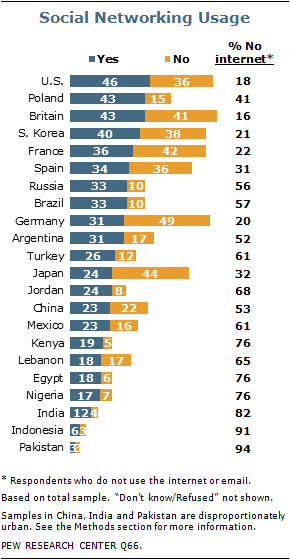 Citizens in the United States are driving the global adoption of social media services such as Twitter and Facebook, according to research conducted by the Pew Research Center in December with over 46% engaged in social networking. Last month they released statistics from another internet snapshot with that number now closer to 59% in the US.
The sites that make up "social networking" do vary a bit by country. For example Orkut (by Google) leads the way in Brazil with 8 in 10 people, as a recent comScore study showed. It was also noted that Twitter.com reached 23% of the entire Brazilian online population, making it the highest penetration in the world (the US is about 8%)
In May of this year a research report from Nielsen showed Facebook in the clear lead across all web brands and commenting that "Facebook has become synonymous not only with social media, but with the Web..." The report showed users spend 23% of their time online across the top 10 social networks.
Citizens in the United States are driving the global adoption of social media services such as Twitter and Facebook, according to research conducted by the Pew Research Center in December with over 46% engaged in social networking. Last month they released statistics from another internet snapshot with that number now closer to 59% in the US.
The sites that make up "social networking" do vary a bit by country. For example Orkut (by Google) leads the way in Brazil with 8 in 10 people, as a recent comScore study showed. It was also noted that Twitter.com reached 23% of the entire Brazilian online population, making it the highest penetration in the world (the US is about 8%)
In May of this year a research report from Nielsen showed Facebook in the clear lead across all web brands and commenting that "Facebook has become synonymous not only with social media, but with the Web..." The report showed users spend 23% of their time online across the top 10 social networks.
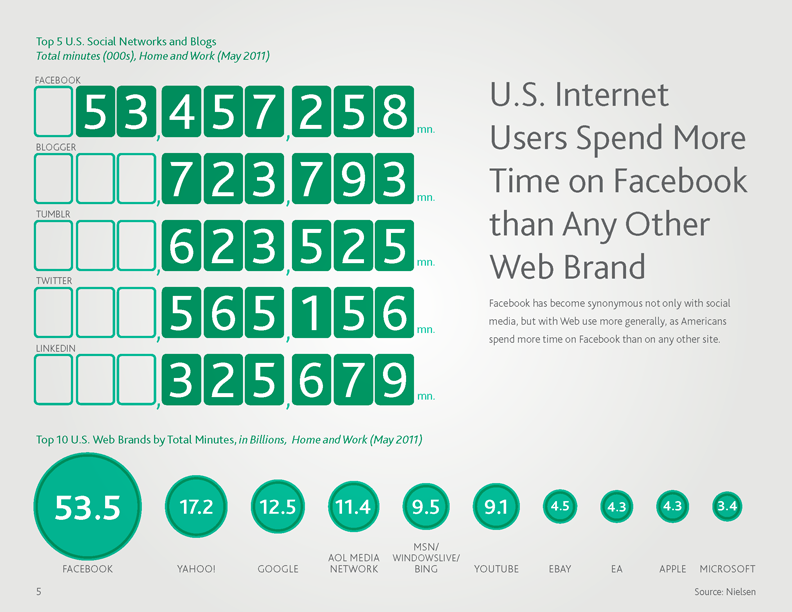 And how is that different from recent years? Citi Investment Research shows us how time spent online has changed from Q3 2006 to Q3 2011. Google and Yahoo - watch out!
And how is that different from recent years? Citi Investment Research shows us how time spent online has changed from Q3 2006 to Q3 2011. Google and Yahoo - watch out!
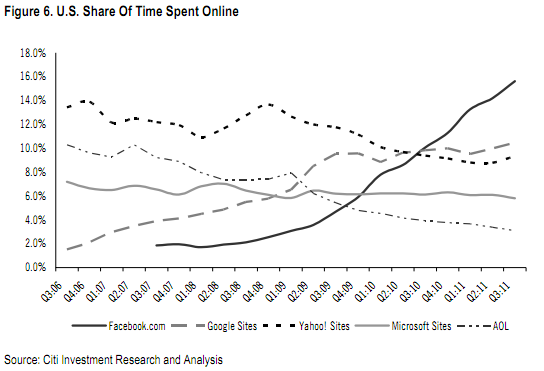 Community is where your customers or potential customers are and it's not necessarily the site you've built. Knowing that - what does your Facebook marketing strategy look like?
Community is where your customers or potential customers are and it's not necessarily the site you've built. Knowing that - what does your Facebook marketing strategy look like? 
 Sometimes, you just need a human to tell you the answer. In the case of local, the majority of information about a location is stored in the brains of humans and not stored in yellow page listings, websites, directory services, and other entities that a machine could sort through.
Sometimes, you just need a human to tell you the answer. In the case of local, the majority of information about a location is stored in the brains of humans and not stored in yellow page listings, websites, directory services, and other entities that a machine could sort through.
 Historically, the local listings services have put up walls to ensure accuracy-- for example, Bing's version. While making it harder to get your listing approved (via long required forms and/or arduous verification) it will provide more complete data but discourages the entry to begin with, further exacerbating the local information problem.
Has Facebook stumbled onto the key to ensure accurate search results by
Historically, the local listings services have put up walls to ensure accuracy-- for example, Bing's version. While making it harder to get your listing approved (via long required forms and/or arduous verification) it will provide more complete data but discourages the entry to begin with, further exacerbating the local information problem.
Has Facebook stumbled onto the key to ensure accurate search results by 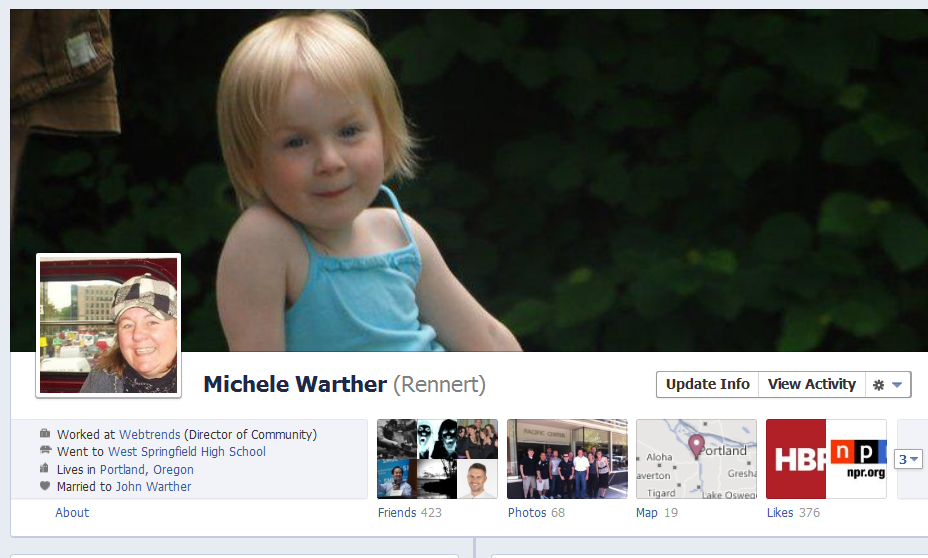
 Map - The map feature plots check-in's and photos across the globe. Also include the new "life events" so you can tag yourself on your honeymoon or the first baby picture at the hospital. The suggest following the tour was to tag your life events, at initial launch I had 19 populated.
Map - The map feature plots check-in's and photos across the globe. Also include the new "life events" so you can tag yourself on your honeymoon or the first baby picture at the hospital. The suggest following the tour was to tag your life events, at initial launch I had 19 populated.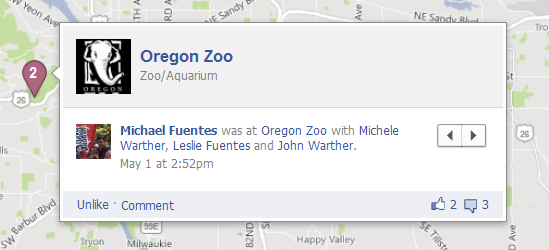 Activities -This is private to you and used for changing permissions for sharing. It's neat reminder of events/posts and you can view by year and month.
Activities -This is private to you and used for changing permissions for sharing. It's neat reminder of events/posts and you can view by year and month.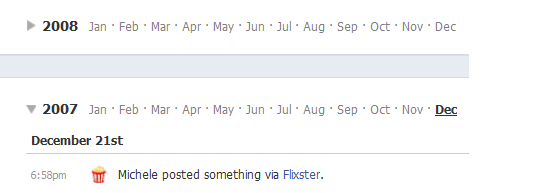

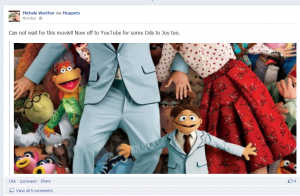 Star or Hide - You can go through each post and star to be featured or hide from your profile. Here's a featured post of a must see movie. Starring the post has it take up the entire width of the page but it's definitely not going to be missed.
Star or Hide - You can go through each post and star to be featured or hide from your profile. Here's a featured post of a must see movie. Starring the post has it take up the entire width of the page but it's definitely not going to be missed. National wanted to measure and improve these campaigns and how visitors used its site overall. But that meant getting many customers registered online first, dealing with IT changes from its recent restructuring, and keeping training time and new equipment purchases to a minimum. National also needed to see how visitors navigated through entire transactions. It wanted to increase site registrations, put energy efficiency information where it would get the best response, and push push push electronic billing.
National wanted to measure and improve these campaigns and how visitors used its site overall. But that meant getting many customers registered online first, dealing with IT changes from its recent restructuring, and keeping training time and new equipment purchases to a minimum. National also needed to see how visitors navigated through entire transactions. It wanted to increase site registrations, put energy efficiency information where it would get the best response, and push push push electronic billing. To learn more about National Grid story -
To learn more about National Grid story -